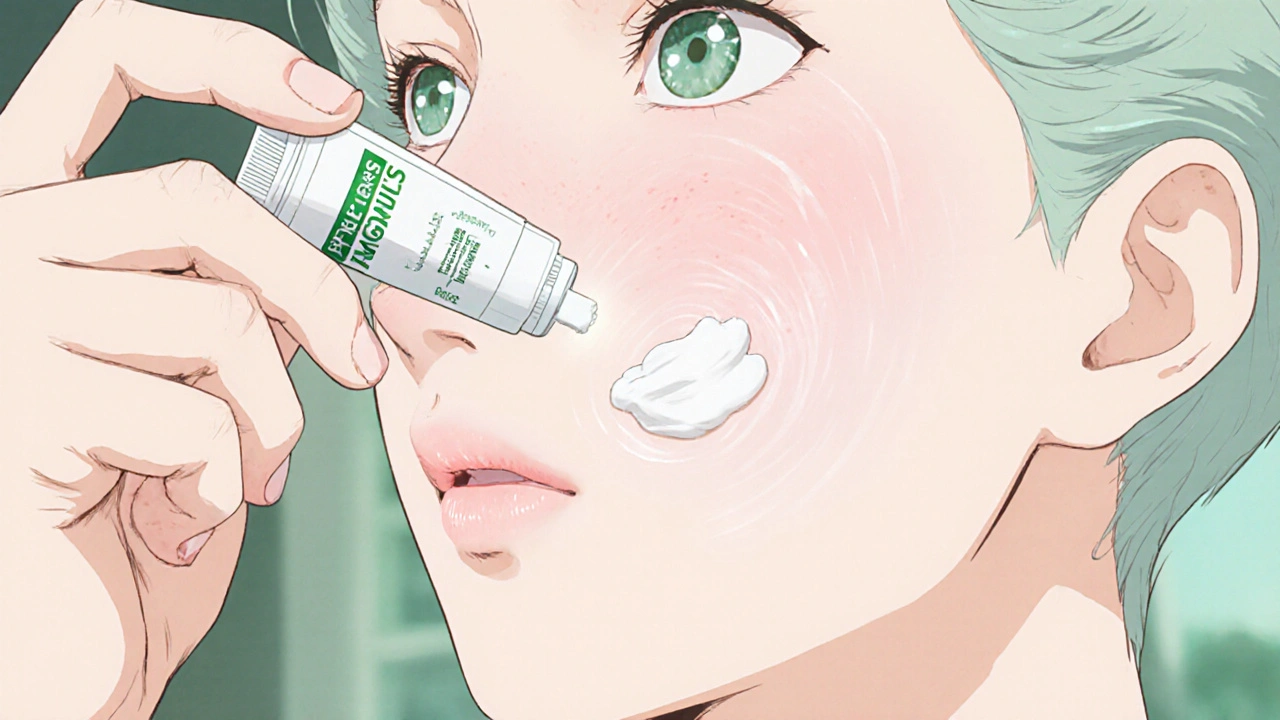Pimecrolimus Cream Calculator
Correct Application Calculator
Based on article recommendations: pea-sized amount (0.5g) per palm-sized area (approx 100cm²)
Recommended amount:
Tip: Use pea-sized amounts (about 0.5g) as shown in article for best results.
Applying pimecrolimus cream the right way can make a huge difference in how quickly eczema or atopic dermatitis clears up and how comfortable your skin feels. This guide walks you through everything you need to know - from prepping the skin to avoiding common blunders - so you get the most out of the medication without unnecessary irritation.
Quick Takeaways
- Always start with clean, gently patted‑dry skin.
- Use a pea‑sized amount for each affected area; more isn’t better.
- Apply in a thin, even layer and let it fully absorb before covering.
- Stick to the prescribed schedule - usually twice daily for the first two weeks.
- Watch for local irritation; report any severe redness or burning to your clinician.
Understanding Pimecrolimus cream is a topical calcineurin inhibitor designed to calm inflammation in skin conditions like eczema and atopic dermatitis
Pimecrolimus works by blocking a protein called calcineurin, which in turn reduces the release of inflammatory cytokines. Unlike traditional steroids, it doesn’t thin the skin, making it a go‑to option for sensitive areas such as the face, neck, and skin folds.
When to Use It
The cream is typically prescribed for:
- Moderate to severe Eczema a chronic, inflammatory skin disorder characterized by itchy, red patches.
- Persistent Atopic dermatitis a subtype of eczema with a strong allergic component that hasn’t responded well to milder moisturizers.
- Highly sensitive skin zones where steroids could cause thinning or striae.
Always follow your dermatologist’s guidance about duration and frequency; many clinicians start with twice‑daily applications for two weeks, then taper based on response.
Preparing Your Skin
Preparation is the foundation of a successful treatment. Follow these steps before each dose:
- Wash gently. Use lukewarm water and a mild, fragrance‑free cleanser. Harsh soaps can strip natural oils and worsen irritation.
- Pat dry. Blot the area with a soft towel; avoid rubbing, which can create micro‑tears.
- Moisturize (optional). If your doctor recommends it, apply a thin layer of a barrier‑repair moisturizer at least 15 minutes before the cream. This helps the skin’s barrier stay intact while still allowing the medication to penetrate.

Step‑by‑Step Application
Now that the skin is ready, here’s how to spread the cream efficiently:
- Measure the dose. A pea‑sized amount (about 0.5g) is sufficient for a palm‑sized patch of skin. Using more doesn’t boost effectiveness and could increase the risk of local irritation.
- Warm the cream. Rub it between your fingertips for a few seconds; a slightly warm product spreads more evenly.
- Apply in thin layers. Gently glide the cream over the affected area, using soft, circular motions. Aim for a uniform film that’s barely visible.
- Allow absorption. Give the skin 5‑10minutes to absorb before putting on clothing or bandages. Covering too soon can trap the product and cause a burning sensation.
- Wash hands. After application, cleanse your hands unless the hands themselves are being treated.
Common Mistakes to Avoid
Even seasoned patients slip up sometimes. Keep an eye out for these pitfalls:
- Over‑application. Using a dollop instead of a pea‑sized amount doesn’t increase benefit and can lead to stinging.
- Skipping the waiting period. Dressing immediately after applying can trap heat and cause a transient burning feeling.
- Applying on broken skin. Open cuts or oozing lesions should be avoided unless your doctor says otherwise; the cream can be absorbed too quickly and cause systemic exposure.
- Interrupting the regimen. Missing doses can prolong flare‑ups. Set a reminder on your phone to stay consistent.
Managing Side Effects
Most users experience mild, temporary sensations: a light tingling, warmth, or slight redness. These usually fade within an hour. However, be alert for:
- Persistent burning or severe itching.
- Swelling or blister formation.
- Signs of infection - increased pus, crusting, or foul odor.
If any of these occur, pause the treatment and contact your dermatologist. They might adjust the frequency, suggest a short steroid “bridge,” or switch you to a different calcineurin inhibitor such as tacrolimus.
How Calcineurin inhibitor a class of immunomodulating drugs that suppress inflammatory pathways in the skin Stands Apart from Topical corticosteroids steroid creams that reduce inflammation but can thin the skin with prolonged use
| Aspect | Pimecrolimus Cream | Topical Corticosteroids |
|---|---|---|
| Drug class | Calcineurin inhibitor | Corticosteroid |
| Mechanism | Blocks calcineurin → reduces cytokine release | Activates glucocorticoid receptors → broad anti‑inflammatory effect |
| Skin thinning risk | Minimal | Potential with long‑term use |
| Typical use areas | Face, neck, skin folds | Extensor surfaces, trunk, less sensitive zones |
| Onset of relief | 7‑10days | 2‑3days |
| Prescription limit | Usually 2weeks, then reassess | Varies by potency; often 1‑2weeks for high‑potency |
Both options have a place in therapy. If you need fast relief on a non‑sensitive area, a low‑potency steroid may be appropriate. For delicate zones or long‑term maintenance, pimecrolimus often wins.
Maintaining Your Skin Barrier
A healthy barrier reduces flare‑ups and makes any medication work better. Pair the cream with these everyday habits:
- Use fragrance‑free moisturizers at least twice daily.
- Avoid hot showers; stick to lukewarm water.
- Wear soft, breathable fabrics - cotton undergarments are best.
- Identify and minimize triggers (e.g., dust mites, certain soaps).
When your barrier stays intact, you’ll notice fewer itchy patches and a smoother response to pimecrolimus.
Frequently Asked Questions
How often should I apply pimecrolimus cream?
Most dermatologists recommend applying a thin layer twice daily (morning and evening) for the first two weeks. After the skin improves, the frequency can be reduced to once daily or every other day, depending on the severity and the doctor’s advice.
Can I use pimecrolimus on my face?
Yes. In fact, pimecrolimus is one of the few anti‑inflammatory creams that is safe for the thin skin on the face because it does not cause the atrophy associated with potent steroids.
Is it safe to use pimecrolimus while pregnant or breastfeeding?
Current data suggest minimal systemic absorption, but the FDA still classifies it as pregnancy category C. Discuss the risks with your obstetrician or pediatrician before using it during pregnancy or while nursing.
What should I do if I experience a burning sensation after application?
A mild tingling is common and usually fades within an hour. If the burning persists for more than 30 minutes or worsens, wash the area gently with water, stop using the cream, and contact your doctor for guidance.
Can I combine pimecrolimus with other eczema treatments?
Yes, many patients use a moisturizer alongside pimecrolimus. Some clinicians also add a short course of low‑potency steroids as a “bridge” while the calcineurin inhibitor takes effect. Always follow a specialist’s plan to avoid drug interactions.
By mastering these simple tips, you’ll give pimecrolimus the best chance to calm inflammation, protect your skin barrier, and keep flare‑ups at bay. Remember: consistency beats occasional over‑application, and a gentle routine is the secret sauce for smoother, healthier skin.

3 Comments
Man, I read that guide and thought it was solid, but honestly you can just slather a pea‑sized dab and call it a day. I usually just mash the tube in my palm and spread it like sunscreen, no big deal. Also, why bother waiting ten minutes before putting on a shirt? The heat from my hoodie dries it faster anyway.
It's kinda wild how every culture has its own ritual for soothing irritated skin-some folks in India swear by neem oil, while many Western families just grab the newest cream off the shelf. I love that this guide respects the science but also leaves room for those age‑old home‑remedies. Sometimes a simple oatmeal bath does wonders before you even think about a prescription. Just remember, consistency beats any magic trick.
Look, I get the whole “follow the doctor’s orders” spiel, but have you ever wondered why big pharma pushes these calcineurin inhibitors so hard? They make a killing, and the side‑effects are conveniently downplayed. Maybe the real solution is to go back to basics-diet, stress management, and avoiding synthetic chemicals altogether. Also, that “pea‑sized” amount sounds like a marketing gimmick to keep you using more. I’m not saying ditch the cream, just stay skeptical of the hype. The skin is a reflection of what we put in our bodies, after all.
Write a comment